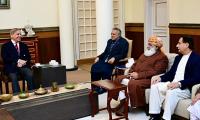This week, July 1, the people of Canada celebrated the 152th birthday of their country. In this connection, various events were held throughout Canada, with people expressing their patriotism and respect for their country and fellow citizens.
Canada was also once ruled by the British. On July 1, 1867, the British parliament passed the British North America Act to form the Dominion of Canada. The act, now known as Constitution Act 1867, resulted in merging the separate colonies of Canada, Nova Scotia, and New Brunswick into a united country. One year later, there were demands for a national day to mark its formation. However, the federal government first recognized Dominion Day in 1879.
The national day was officially named Canada Day in 1982. Over the years, Canadians have embraced the national holiday, with a purpose to celebrate the country’s rich history and noble achievements.
The history of the Canadian flag is also quite interesting. It is a result of the years-long struggle of the Canadian people to distinguish Canada as a sovereign independent country and reflect its self-governance. Historically, it was proposed in 1895 that Canada must have its own national flag. At that time, despite independence from the British, the Union Jack was used in Canada.
After 30 years, a committee of the Privy Council started researching possible designs but was unable to deliver the required results. In 1946, once again a similar task was given to a parliamentary committee which received more than 2,600 designs. Due to the volume, it was quite difficult to call upon parliament to formally vote.
In 1964, then prime minister of Canada Lester B Pearson announced in the House of Commons that the government was interested in adopting a distinctive national flag. As a result, submissions for flag designs were called once again. Finally, the House of Commons, in a resolution on December 15, 1964, approved the current design of national flag; this was followed by the Senate on December 17, 1964.
Finally, on February 15, 1965 Queen Elizabeth II participated in an official ceremony, held at Parliament Hill, to raise the new maple leaf flag. The enthusiastic crowd was singing the national anthem, “O Canada”, followed by the royal anthem, “God Save the Queen.”
On the occasion, the then speaker of the Senate Maurice Bourget also elaborated the symbolic meaning of the flag, saying that: “The flag is the symbol of the nation’s unity, for it, beyond any doubt, represents all the citizens of Canada without distinction of race, language, belief or opinion.”
Today, Canada is one of the most developed countries in the world, and has opened its doors for all those who are talented. According to media reports, the expected number of new permanent residents this year is 330,800 and is expected to rise to 341,000 in 2020 and 350,000 for 2021. Canada is also one of the most educated countries. Every year, Canadian universities succeed to attract a large number of foreign students.
Its advanced economy is considered among the top ten largest economies in the world. Canada is an active member of several prominent international forums, such as: the UN, Nato, the G7, the Group of Ten, the G20, the North American Free Trade Agreement and the Asia-Pacific Economic Cooperation. Being a founding member of the UN, Canada’s foreign policy is based on world peace and international harmony. Its peacekeeping efforts are widely recognized in every part of the world.
Canada is religiously a diverse country; the ‘Fundamental Freedoms’ section of the Canadian Charter of Rights and Freedoms ensures liberty for every citizen to practise his/her faith. There is strict prohibition on promoting hatred on the basis of colour, race, gender, religion, ethnic origin, etc. The Canadian government is also committed to support other countries to ensure religious freedom there.
I have visited Canada many times and what I observe is that today, Canada is a sovereign independent country which is playing a pivotal role for the promotion of world peace, cultural and religious harmony, and strengthening democracy at all levels. The tireless struggle of the Canadian people for adopting their national flag demonstrates that genuine nations never ever give up on their national agendas.
The writer is a member of the NationalAssembly and patron-in-chief of thePakistan Hindu Council.
Twitter: @RVankwani
Many people believe that in future, AI will play an even more significant role in their lives
In April 2024, three Chinese and one Belarusian company were sanctioned for exporting missile-enabling technology to...
Pakistan has second highest neonatal mortality in world; in education sector, country's 26 million kids are out of...
Key actors in global power politics are US, China, Russia, European Union, and emerging powers such as India and Brazil
Maulana Fazl manages to bring together factions that historically stand opposed
NASA says August 2024 set new monthly temperature record, capping Earth’s hottest summer since 1880







